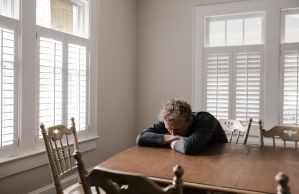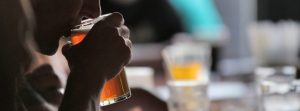Lip (short for Phillip) is a strong young adult, who has overcome more than most of us experience in a lifetime. As a teen in high school, his primary concerns were putting food on the table, paying the bills, and taking care of his four younger siblings alongside his older sister Fiona. Somehow, however, he also managed to stay on top of his schoolwork, earn his diploma, and get accepted to a local university—he became the first Gallagher to do so. Lip knew this was an extraordinary accomplishment, but what he didn’t know was how difficult the next few years would be. He struggled in the advanced college courses, experienced a few blunders in love, and battled with ghosts of his past. Ultimately, it became all too overwhelming, and he turned to drinking—which proved to wreck Lip’s world.
Having a beer or two was normal for Lip—he’d been doing it since he was a kid. But now he was having a beer or two in the morning, a few throughout the afternoon, and some whiskey to top it off in the evening. He started drowning himself in alcohol, he made bad decisions because of it (which he wouldn’t remember the next day), and he couldn’t imagine functioning without it. Lip found himself in a downward spiral: he violated the code of student conduct and got kicked out of school; he got into drunk arguments with his loved ones; and he landed himself in jail. Despite these should-be wakeup calls, however, Lip continued drinking.
Substance Use Disorder and Addiction
What started out as innocent behavior, turned into a problem. Lip—who is actually a fictional character on the popular Showtime series Shameless—developed substance use disorder: a condition in which the use of one or more substances (such as alcohol) proves detrimental to an individual’s wellbeing. This issue can emerge due to a number of reasons, such as stress, relationship issues, learned behavior… or even a combination of several causes. In Lip’s case, the addiction is rooted in all of the above.
As you can see with Lip, it is often difficult to admit or even recognize that you have a problem; it may be obvious to an outsider looking in, but it’s easier for the affected individual to deny, deny, deny. The best bet is to educate yourself on warning signs and symptoms, as well as listen to worried loved ones who express their concerns.
Signs You May Have a Problem
Substance use disorder is not a simple disease—instead, it can be divided into three levels of varying degrees: mild, moderate, and severe. The level determined by a mental health profession depends on how many symptoms you exhibit, with a greater number of symptoms signifying a more severe problem. Here are the 11 potential symptoms to look for if you’re worried you (or someone else) may have a drinking problem, as rooted in substance use disorder:
- Use of the substance over a longer period of time, or in a larger amount, than intended
- An inability to cut back on the substance even when you want to
- Ongoing urge to use the potentially harmful substance
- Failure to uphold responsibilities at work or school, due to the substance use
- Significant time investment in obtaining the substance
- Continuous use of the substance, despite its negative effects on your relationships
- Absence at significant events, due to the substance use
- Continual use even if/when the substance puts you in danger
- Presence of withdrawal symptoms when you stop using the substance for any given amount of time
- Use of the substance, despite your knowledge of its potential to exacerbate current physical or psychological problems
- Increased tolerance to the substance
Treatment for Your Addiction
Lip has a difficult time accepting and admitting that he has a problem—but with the help of loved ones, he does eventually recognize his drinking problem for what it is, and he seeks treatment. Now, treatment can involve a few different interventions, which vary in effectiveness from person to person. Options include…
1) Counseling
Oftentimes, treatment starts and ends here for those who suffer with substance use disorder. Counseling, whether it be in an individual or group setting, is highly effective and typically leads to promising results. These therapy sessions involve teaching the patient to adapt healthier behavior and thought patterns, as well as how to better manage their addiction. This is Lip’s primary form of treatment, and so far, it has helped him battle his inclinations to drink.
2) Medication
Treating substance use disorder with medications can be tricky, considering these individuals are at a heightened risk of becoming dependent on a given substance. If done correctly, however, it can also be a successful form of treatment. A mental health professional will determine potentially effective medications for a given individual (which may take some experimentation) and come up with a promising plan that will hopefully yield promising results.
3) Inpatient Facilities/Rehab
Inpatient facilities, which are better known as rehab, have proven time and time again to help individuals defeat their addictions. This may require a time commitment as short as a few days, or as long as several months. Regardless of the time frame, the goal of inpatient facilities or rehab is to free patients of their addiction and all of the issues that come with it. This is another form of treatment that helped Lip recognize his drinking problem and overcome it.
Get Help Today
If you have a drinking problem—or think you might have a drinking problem—take that leap of faith and seek treatment today. A counselor at Thriveworks can help determine whether or not you have a problem and also help you manage that problem. Simply click here to see a counselor or coach, or call us at 1-855-4-THRIVE. We are here to help!













